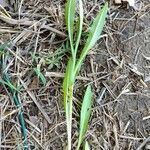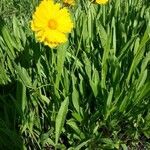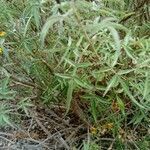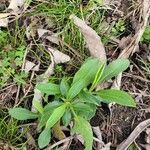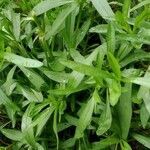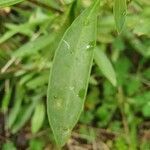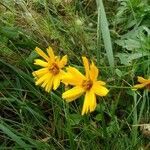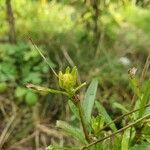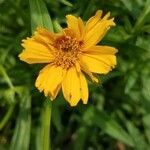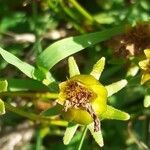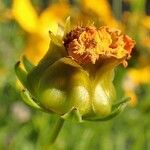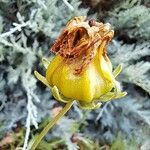Clump-forming mostly perennial herb, 0.2–0.75 (–1.2) m high; stems usually sparsely pubescent below, glabrous above. Basal leaves rosette-forming; petiole 2–8 cm long; lamina lanceolate to spathulate, 4–30 mm long, 10–20 mm wide, entire, with 2 basal lobes, or rarely pinnate, sparsely to densely hairy on both surfaces. Internodes to first peduncle usually 1–3; cauline leaves confined to lower ½ of scape, opposite, linear to narrowly lanceolate (rarely with 1 or 2 basal lobes or pinnate), sessile. Capitula (4–) 6–10 cm diam.; outer involucral bracts herbaceous, usually lanceolate, 5–10 mm long, usually ciliate apically (rarely hyaline); inner bracts herbaceous, ovate, 10–15 mm long, with margins hyaline, glabrous. Ray florets c. 8; ligule 2–3 cm long, yellow. Disc florets 5-lobed, yellow. Achenes 2.0–3.5 mm long, ±cucullate, winged, black, glabrous or with sparse white hairs. Pappus awns minute, antrorsely barbed.
Clustered perennial 2–6 dm from a short caudex, glabrous or spreading-villous; stems leafy below, elongate and naked above; lvs spatulate to linear or lance-linear, simple or with 1 or 2 pairs of small lateral lobes, the lower long-petiolate, mostly 5–20 cm overall and 0.5–2 cm wide; the others reduced and sessile or nearly so; heads few or solitary on long, naked peduncles, the disk yellow, 1–2 cm wide; outer bracts 8–10, lanceolate to oblong-ovate, ± scarious-margined, 5–10 mm; inner bracts longer and broader; rays 1.5–3 cm; receptacular bracts flat and chaffy below, caudate-attenuate above; disk-fls 5-toothed; style appendages cuspidately acute; achenes 2–3(–4) mm, orbicular or broader, with thin, flat wings; pappus of 2 short, chaffy teeth; 2n=24, 26, 48. Dry, often sandy places; Mich. and the n. shore of Lake Superior to Fla. and N.M.; cult. and often escaped. Apr.–June. (C. crassifolia; C. heterogyna)
Perennials, 10-30(-60+) cm. Aerial nodes proximal to first peduncle usually 1-3(-5+), distalmost 1-3 internodes 1-2(-8+) cm. Leaves: basal and cauline on proximal 1/4-1/3(-1/2) of plant height; petioles 1-5(-8+) cm; blades simple or with 1 or 2+ lateral lobes, simple blades or terminal lobes ovate-lanceolate or lanceolate to oblanceolate or linear-lanceolate, 5-12 cm × 8-15(-18+) mm. Peduncles (8-)12-20(-35+) cm; calycular bracts ovate-lanceolate to linear-lanceolate or linear, 4-8(-12) mm; phyllaries deltate to dentate-lanceolate, 8-12+ mm. Ray limbs yellow, 15-30+ mm. Disk corollas 6-7.5 mm, apices yellow. Achenes 2.6-4 mm, wings ± spreading, ± papery, entire. Fl. May-Jul. 2n = 26.
Perennials, 10–30(–60+) cm. Aerial nodes proximal to first peduncle usually 1–3(–5+), distalmost 1–3 internodes 1–2(–8+) cm. Leaves: basal and cauline on proximal 1/4–1/3(–1/2) of plant heights; petioles 1–5(–8+) cm; blades simple or with 1–2+ lateral lobes, simple blades or terminal lobes lance-ovate or lanceolate to oblanceolate or lance-linear, 5–12 cm × 8–15(–18+) mm. Peduncles (8–)12–20(–35+) cm. Calyculi of lance-ovate to lance-linear or linear bractlets 4–8(–12) mm. Phyllaries deltate to lance-deltate, 8–12+ mm. Ray laminae yellow, 15–30+ mm. Disc corollas 6–7.5 mm, apices yellow. Cypselae (2.6–)3–4 mm, wings ± spreading, ± chartaceous, entire. 2n = 26 (+ 0–4B).
Perennial herb, stems and leaves thinly hairy. Basal leaves crowded, up to c. 20 x 3 cm, oblong to linear, entire, tapering to the base and half-clasping. Flowering stems up to c. 0.5 m, subsimple, leafy, lower leaves pinnatisect, upper entire. Heads showy, solitary on very long nude peduncles, about 6 cm across the expanded rays. Rays c. 8, limb oblong-obovate, they and the disc bright yellow. Achenes c. 3 x 3 mm, orbicular in outline, compressed, concave, broadly winged.
Perennial herb, up to 500 mm tall. Basal leaves crowded, oblong to linear, entire, tapering to base and half clasping; on flowering stems: lower pinnatisect, upper entire. Heads solitary on long, nude peduncles. Flowers bright yellow.
A cultivated carpet-forming herb with large yellow ray florets.
